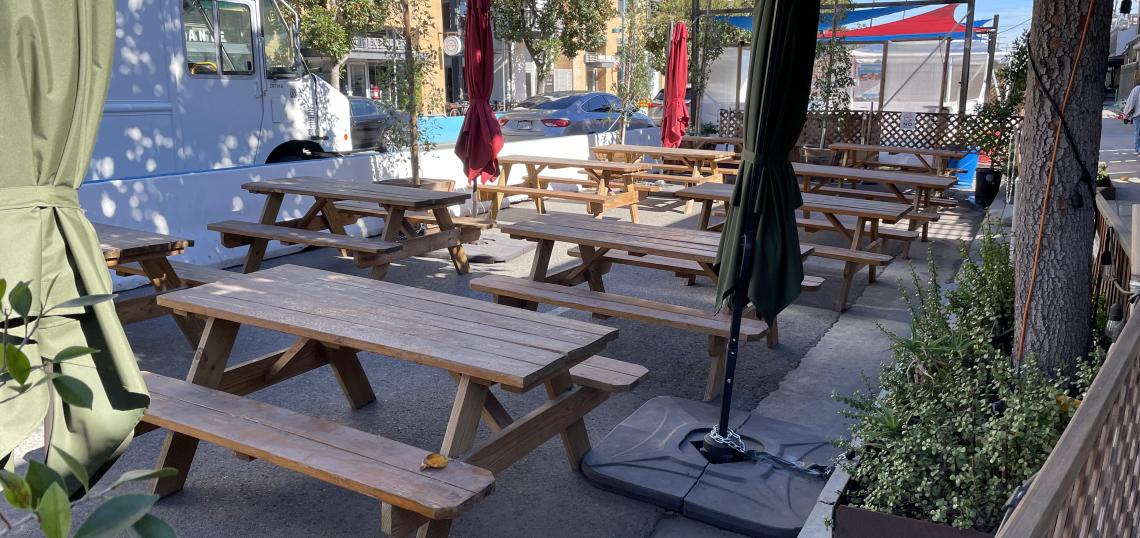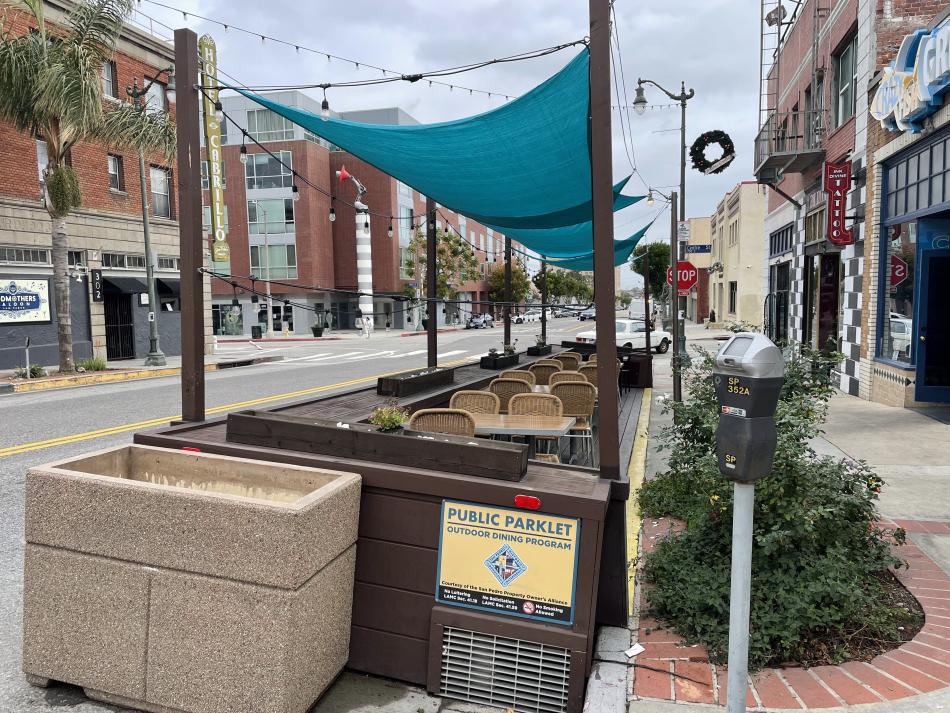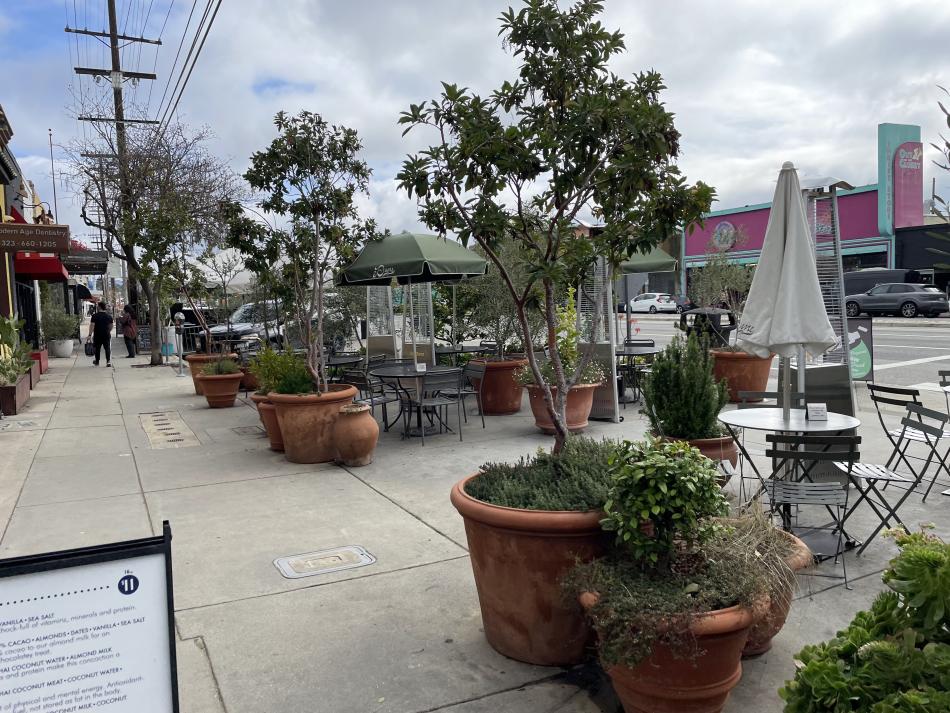In a substantial boost to restaurants, bars, and cafes grappling with the challenges of the COVID-19 pandemic, the temporary L.A. Al Fresco outdoor dining program served as a crucial lifeline. The ability to convert parking spaces into dining and increase commercial space turned Al Fresco into a success story.
A recent economic analysis of the program, comparing parking meter revenue to sales tax revenue and evaluating treatment corridors with high levels of business participants in the L.A. Al Fresco program against control corridors without it, yielded impressive results. The study revealed the program's effectiveness in preserving the viability of over 80% of businesses during the pandemic. Particularly striking was the $12 million surge in gross sales witnessed in treatment corridors with Al Fresco in 2022 compared to the pre-pandemic year of 2019. As the L.A. Al Fresco program transitions into a permanent ordinance, the City of Los Angeles anticipates not only economic benefits but also significant positive social implications.
Background on research and program
Prompted by several key questions, my recent research, "Dining or Parking? Managing the Curb During COVID-19 and Beyond: An Analysis of the L.A. Al Fresco Program," unfolded in collaboration with urban planning expert Donald Shoup. This investigation was a pivotal component of my Master’s in Urban and Regional Planning at the UCLA Luskin School of Public Affairs. LADOT's L.A. Al Fresco division served as our client through the UCLA Institute of Transportation Studies. With guidance from Senior LADOT Transportation Planner Jaclyn Garcia, we gathered data to evaluate the impact of the temporary COVID-era Al Fresco outdoor dining initiative. Our research compared revenue from parking meters and sales tax in high-participation L.A. Al Fresco corridors. The findings revealed the program's success in not only sustaining businesses during the pandemic but also driving a remarkable $12 million increase in sales compared to pre-pandemic 2019. This boost is credited to restaurants expanding their space and dining capacity, with minimal impact on meter revenue.
In collaboration with parking expert Donald Shoup, my research aimed to assess the L.A. Al Fresco program's overall effectiveness by comparing sales tax revenue to potential parking meter loss. The objective was to determine whether there was a compelling case for the City of Los Angeles to establish a permanent successor program and if there were any impacts to the parking supply locally.
“Until COVID-19 arrived, Los Angeles required all restaurants to provide off-street parking for their customers. During COVID, Los Angeles adopted its Al Fresco program, allowing restaurants to convert their required parking lots into outdoor dining spaces," said Shoup. "Graham Rossmore, a UCLA graduate student in urban planning, studied the results. Rossmore found that Al Fresco produced enormous benefits and turned out to be the most popular way to stay healthy during the pandemic. Many restaurants and their customers discovered that outdoor dining is more important than free parking. It’s rare for a planning student’s research to change public policy so quickly, but Rossmore’s study helped convince the Los Angeles City Council to make Al Fresco permanent.”
San Pedro, A Cohesive Approach to Outdoor Dining
Nestled in the heart of downtown San Pedro is a bustling historic neighborhood distinguished by its transit-oriented commercial center and a dynamic blend of residential and commercial activities. Aligned with the vision set forth in the San Pedro Community Plan, the area champions a walkable downtown experience underscored by a diverse array of amenities and green spaces, all while prioritizing pedestrian-friendly streets. Notably, commercial land comprises a modest 6% of the total area, with residential land commanding a significant 65%, featuring a harmonious mix of single-family and multi-family homes. The overarching goal of the plan revolves around fostering affordability, denser neighborhoods, and a well-balanced community.
Now-Counclmember Tim McOsker (CD15), who was then a vocal advocate of the San Pedro Property Owners’ Alliance/San Pedro Historic Waterfront Business Improvement District (PBID), played a pivotal role in advocating for curbside, parklet dining well before the inception of the L.A. Al Fresco program. Recognizing the potential of outdoor dining in on-street parking spaces to invigorate the local community, McOsker championed the cause, emphasizing the positive impact on both businesses and residents. The BID’s active engagement, foresight and proactive stance laid the groundwork for a cohesive approach that seamlessly integrated into the pandemic-inspired LADOT L.A. Al Fresco program. This collaborative effort not only contributed to the success of the program overall but also garnered widespread support and enthusiasm from the residents of San Pedro. The community's welcoming embrace of the program is a testament to the thoughtful advocacy and strategic vision led by BID for the implementation of curbside dining.
James Brown, who has operated the San Pedro Brewing Company on West 6th Street for the past 24 years, expressed gratitude for the temporary Al Fresco program, highlighting the blessing it brought by allowing them to convert their mandatory private off-street lot. The flexibility to temporarily ease the minimum parking requirements outlined in the Los Angeles zoning code for restaurants and retail has proven to be the most successful aspect of the program. This is evident in the overwhelming majority of applicants opting for this option over curbside or sidewalk outdoor dining. San Pedro Brewing also reported an increase in foot traffic, visibility, and overall dining experience by customers.
In a remarkable development, San Pedro experienced a substantial surge of over $7 million in gross sales across the 13 restaurants that participated in L.A. Al Fresco in 2022, as compared to the pre-pandemic year of 2019. In 2019, these establishments collectively generated $4 million in gross sales, whereas, in 2022, their combined sales skyrocketed to an impressive $11 million during the same period—a staggering increase of over $7 million in downtown San Pedro alone. The expanded floor space and a harmonized design approach have positioned the coastal neighborhood as one of the most alluring destinations for al fresco dining in Los Angeles.
Economic Disparities of the L.A. Al Fresco Program
Similar research, conducted by Brittany Montaño, a fellow UCLA Luskin MURP 2023 alumna, revealed that nearly 27% of active restaurants in Los Angeles have taken part in the L.A. Al Fresco outdoor dining initiative. Montaño's research with UCLA’s Madeline Brozen, “Al Fresco in the Time of COVID-19: Addressing the Barriers to Outdoor Dining in Los Angeles Communities”, involved interviewing various establishments in lower income communities across the city, all of which disclosed their application for financial support through programs such as the Paycheck Protection Program (PPP) to sustain operations amid the pandemic. Some businesses faced challenges in accessing assistance from the City of Los Angeles Small Business Rental Assistance grant program, an issue which was attributed to their innovative approaches to generate additional revenue during the pandemic, such as selling bottled iced coffee. The rental assistance grant program specifically required evidence of pandemic-induced economic hardship, which these businesses did not meet due to their alternative revenue streams.
While this study highlights how some neighborhoods felt the temporary Al Fresco program was out of reach, many neighborhoods in Los Angeles commended the program; the Mid-City West Neighborhood Council lauded the program’s success in breathing life into once-deserted parking lots, transforming them into vibrant spaces filled with people relishing their meals. The Los Feliz Neighborhood Council, representing a substantial number of restaurants and their patrons, not only backed the temporary initiative but also advocated for its permanence and the ability to permit ambient music outdoors. Underlining the significance of outdoor seating, these neighborhoods have highlighted its pivotal role in supporting local restaurants and fortifying adjacent retail establishments. This, they argue, contributes substantially to the overall economic prosperity of Los Angeles. The city's complementary weather, conducive to outdoor dining, further amplifies the positive impact of this initiative, creating a symbiotic relationship between the community and its thriving dining and retail scene.
What About Meter Revenue Loss Locally?
Claiming thirteen coveted on-street parking spaces, San Pedro's curbside restaurants generated nearly $14,000 from these same meters in 2019, averaging approximately $1,000 per meter per year. This pre-pandemic baseline becomes crucial when considering potential losses in meter revenue. However, the news is optimistic, as the impressive surge in sales tax has more than offset any potential setback in meter revenue, showcasing a resilient and thriving economic landscape in the heart of San Pedro. My research finds that converting spaces for cars into places for people provides both social and economic benefits for residents, business owners and the City of Los Angeles.
Currently, 100% of money deposited into the parking meter vanishes from the neighborhood and enters the black hole of city revenue-budget streams. The money paid at the meters in Los Angeles departs the neighborhood and gets spent at the discretion of LADOT for projects citywide. The City Council’s previous attempts at keeping that meter money local were unsuccessful in gaining traction. As the city recovers from the pandemic, and meter revenue gradually rebounds to pre-pandemic levels, it becomes opportune to witness the realization of this program. Subsequently, parking meters could play a pivotal role in supporting local neighborhoods by allocating a portion of the revenue towards community enhancements, such as improvements for pedestrians, traffic management, street beautification with trees and lights, and the upkeep of sidewalks and streets. Rather than opposing paid parking, individuals may find joy in the immediate benefits derived from reinvesting that revenue within the local community.
Permanent L.A. Al Fresco
The final ordinance for curbside/on-street dining mandates Al Fresco participants to submit a one-time, non-revocable permit fee of $1,200 for businesses with an existing temporary authorization and $1,500 for new establishments.
Under the soon-to-be permanent L.A. Al Fresco regulations (CF 20-1074), restaurants are now required to keep at least one parking space for cars if converting their private off-street parking lot into outdoor dining. Businesses are also restricted from incorporating background music and speakers, television monitors, and live music in their outdoor dining areas. Participating businesses must also adhere to specific guidelines, including closing by 10:30 p.m. from Sundays through Thursdays and no later than 11 p.m. on Fridays and Saturdays. It is mandatory to display a sign in the outdoor dining area reminding guests to be considerate of their neighboring residents. Noise-related issues will be addressed by the Los Angeles Police Department. The Council has adopted the final ordinance and it now awaits signature from Mayor Bass.
____
Bio:
Graham Rossmore is an urban planner and UCLA Luskin MURP alum 2023. His primary focus is transportation policy, planning, parking and curb management, and active transportation projects. In 2023, Graham was elected to serve on the board of the Hollywood Hills West Neighborhood Council. In this role, he passionately advocates for greater access to affordable housing, and greater access to public resources like water and utilities.









